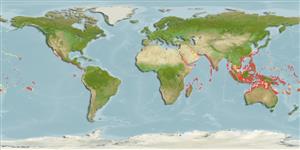Common names from other countries
Environment: milieu / climate zone / depth range / distribution range
Écologie
marin récifal; profondeur 1 - 40 m (Ref. 9710), usually 10 - 25 m (Ref. 27115). Tropical; 24°C - 28°C (Ref. 27115); 30°N - 23°S, 180°W - 180°E
Indo-Pacific: Red Sea south to East London, South Africa (Ref. 5469) and east to the Marquesan Islands, north to the Mariana Islands, south to New Caledonia. Eastern Pacific: Gulf of California to Colombia and the Galapagos Islands (Ref. 9289).
Taille / Poids / Âge
Maturity: Lm ? range ? - ? cm
Max length : 10.0 cm TL mâle / non sexé; (Ref. 9289)
Épines dorsales (Total) : 10; Rayons mous dorsaux (Total) : 12 - 13; Épines anales: 3; Rayons mous anaux: 6. Highly variable in color from pale with grey to black blotches to pink with bright red blotches (Ref. 48636). Pale with horizontal rows of subquadrate dark brown spots; a row of smaller spots on LL between larger spots; small dark brown spots on head (Ref. 5469).
Inhabit areas of rich coral growth and clear water of lagoon, channel, or seaward reefs from below the surge zone to depths of at least 40 m. They rest on, in, or beneath hard or soft corals. Feed on crustaceans and small fishes (Ref. 37955). Males are territorial and haremic (Ref. 37816).
Life cycle and mating behavior
Maturities | Reproduction | Spawnings | Egg(s) | Fecundities | Larves
Pelagic spawner (Ref. 31569). Spawning ascents into the water column occurred over a distance of 0.3 to1.0 m (Ref. 26305).
Randall, J.E., G.R. Allen and R.C. Steene, 1990. Fishes of the Great Barrier Reef and Coral Sea. University of Hawaii Press, Honolulu, Hawaii. 506 p. (Ref. 2334)
Statut dans la liste rouge de l'IUCN (Ref. 130435)
CITES (Ref. 128078)
Not Evaluated
Menace pour l'homme
Harmless
Utilisations par l'homme
Pêcheries: commercial; Aquarium: Commercial
Outils
Articles particuliers
Télécharger en XML
Sources Internet
Estimates based on models
Preferred temperature (Ref.
115969): 23.2 - 25.9, mean 24.9 (based on 42 cells).
Phylogenetic diversity index (Ref.
82804): PD
50 = 0.5039 [Uniqueness, from 0.5 = low to 2.0 = high].
Bayesian length-weight: a=0.01380 (0.00661 - 0.02881), b=3.02 (2.83 - 3.21), in cm Total Length, based on LWR estimates for this species & (Sub)family-body (Ref.
93245).
Niveau trophique (Ref.
69278): 4.0 ±0.66 se; based on food items.
Fishing Vulnerability (Ref.
59153): Low vulnerability (10 of 100).
